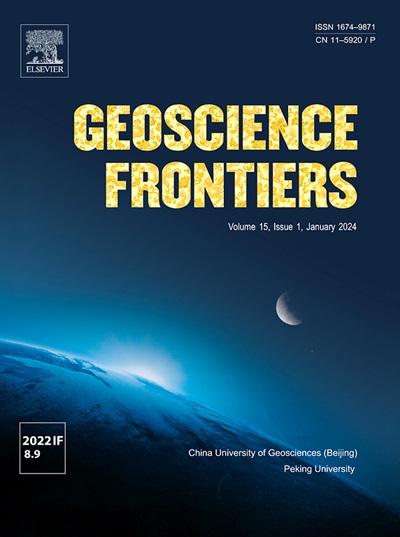地球最底层地幔中含铁硅酸盐后透辉石的压缩波和剪切波速度
IF 8.9
1区 地球科学
Q1 GEOSCIENCES, MULTIDISCIPLINARY
引用次数: 0
摘要
从桥粒石(Bgm)到硅酸盐后透辉石(PPv)相转变被认为是在地球地幔最底层 D''层观测到明显地震特征的主要原因。然而,由于 D''层内的化学复杂性会在很大程度上影响 Bgm-PPv 转换压力和相关的速度对比,因此 PPv 相的转换深度和弹性一直备受争议。在相关的最下地幔条件下,对不同化学成分的 PPv 的声速进行实验测量非常重要,但仍然有限。在这项研究中,我们利用脉冲刺激光散射(ISS)、布里渊光散射(BLS)和 X 射线衍射(XRD)技术,在金刚石砧室中对两种含铁 PPv 成分[(MgFe)SiO 和 (MgFe)SiO]在最下地幔压力下的压缩波速度()、剪切波速度()和密度进行了可靠的测量。我们的研究结果表明,含铁 PPv 在 120 GPa 时的速度可用以下关系描述:(km/s)= 7.65-2.8 和(km/s)= 14.11-3.8,其中,(km/s)代表铁含量的摩尔分数。PPv 中铁含量的变化可能是地核地幔边界地震横向变化的原因之一。通过将我们的结果与 Bgm 的高压速度进行比较,我们的速度模型表明,在 Bgm-PPv 的转变过程中存在明显的不连续性,其特征是 ,和 ,均有所下降,而 ,则有所上升。这些发现凸显了考虑化学成分,尤其是铁含量对 PPv 相地震特性影响的重要性,因为铁含量在 D''区域可能有显著变化。在 Bgm-PPv 相转变过程中观测到的速度对比可能是在 D''层观测到的复杂地震特征的原因,突出了该相转变在解释最下地幔区地震特征方面的潜在作用。本文章由计算机程序翻译,如有差异,请以英文原文为准。

Compressional and shear wave velocities of Fe-bearing silicate post-perovskite in Earth’s lowermost mantle
The bridgmanite (Bgm) to silicate post-perovskite (PPv) phase transition is believed to be the main cause for the distinct seismic features observed in the D'' layer, the lowermost region of the Earth’s mantle. However, the transition depth and elasticity of the PPv phase have been highly debated, as the chemical complexity within the D'' layer can largely affect the Bgm-PPv transition pressure and the associated velocity contrast. Experimental measurements of sound velocities for PPv with different chemical compositions under relevant lowermost-mantle conditions are essential but remain limited. In this study, we have reliably measured both compressional wave velocity (VP), shear wave velocity (VS), and density, for two Fe-bearing PPv compositions [(Mg0.85Fe0.15)SiO3 and (Mg0.75Fe0.25)SiO3] at lowermost mantle pressures using Impulsive Stimulated Light Scattering (ISS), Brillouin Light Scattering (BLS), and X-ray Diffraction (XRD) in diamond anvil cells. Our results indicate that the velocities of Fe-bearing PPv at 120 GPa can be described by the following relationships: VS (km/s) = 7.65–2.8XFe and VP (km/s) = 14.11–3.8XFe, where XFe represents mole fraction of the Fe content. The variations in the Fe content of PPv may provide one of the explanations for the seismic lateral variations observed at the Earth’s core mantle boundary. By comparing our results with the high-pressure velocities of Bgm, our velocity model suggests significant discontinuities across the Bgm-PPv transition, characterized by a reduction in both VP and VΦ, and an increase in VS. These findings highlight the importance of considering the influence of chemical composition, particularly Fe content which could vary significantly at the D'' region, on the seismic properties of the PPv phase. The observed velocity contrasts across the Bgm-PPv transition may contribute to the complex seismic signatures observed in the D'' layer, underscoring the potential role of this phase transition in interpreting the seismic features of the lowermost mantle region.
求助全文
通过发布文献求助,成功后即可免费获取论文全文。
去求助
来源期刊

Geoscience frontiers
Earth and Planetary Sciences-General Earth and Planetary Sciences
CiteScore
17.80
自引率
3.40%
发文量
147
审稿时长
35 days
期刊介绍:
Geoscience Frontiers (GSF) is the Journal of China University of Geosciences (Beijing) and Peking University. It publishes peer-reviewed research articles and reviews in interdisciplinary fields of Earth and Planetary Sciences. GSF covers various research areas including petrology and geochemistry, lithospheric architecture and mantle dynamics, global tectonics, economic geology and fuel exploration, geophysics, stratigraphy and paleontology, environmental and engineering geology, astrogeology, and the nexus of resources-energy-emissions-climate under Sustainable Development Goals. The journal aims to bridge innovative, provocative, and challenging concepts and models in these fields, providing insights on correlations and evolution.
 求助内容:
求助内容: 应助结果提醒方式:
应助结果提醒方式:


